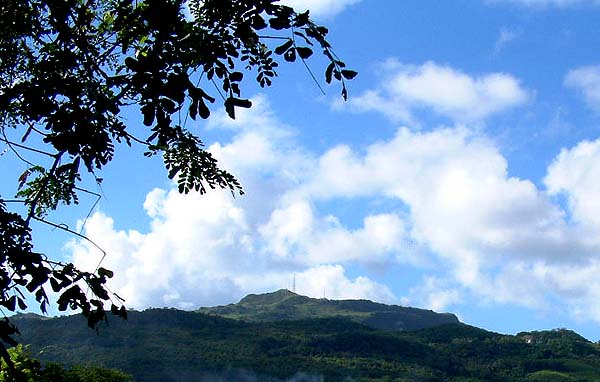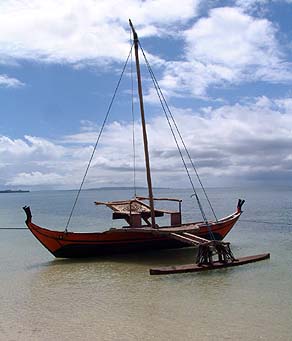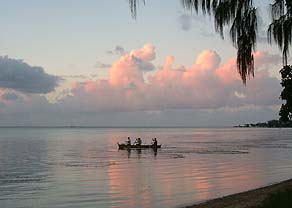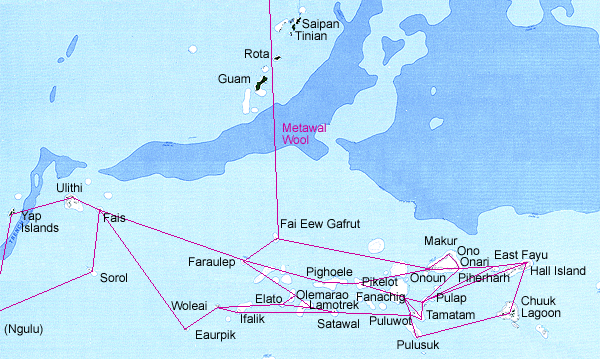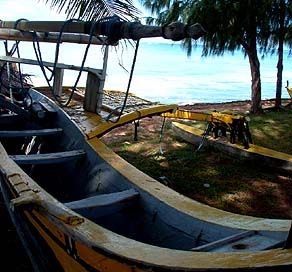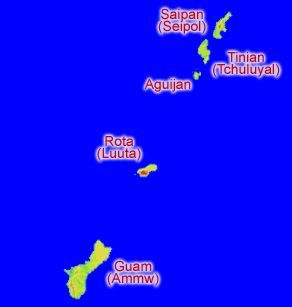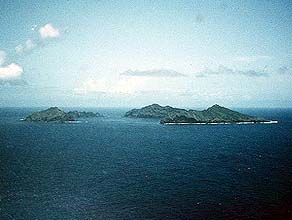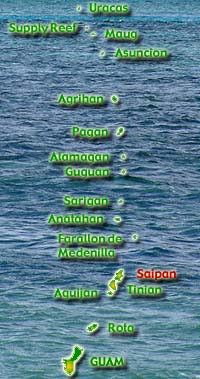 |
 |
 |
|||||
|
|
|
|
|
|
|
|
|
|
|
|||||||
| |
|
|
Mt. Tapochau, from the Kagman side.
|
There are two versions about how the name “Saipan” came about, and these reflect the two cultures of the Northern Marianas. While very few Chamorro tales remain, we hear one about this particular place name. Lino Olopai translates a conversation between elders Mr. Seles and Mrs. Sablan:
|
||
|
|
||
“The story goes that there were three strong men: Taga of Tinian, Tangolung from Rota, and the strong man from Saipan. They all got together on the Island of Tinian with Taga. And they were getting ready to have dinner. But the strong man from Saipan decided not to stay for dinner, because he was anxious to come back to the island of Saipan. "And they asked him ‘why are you anxious to get back to Saipan?’ and he said ‘Because of pon.’ Pon refers to a woman's intimacy. The strong man of Saipan uses the word pon to say that he needs to come back to be with his wife. Mr. Seles says that that’s how the name of Saipan came about."
|
|
|
“Mrs. Sablan, on the other hand, shakes her head in disagreement and perhaps disbelief. She says she has heard of that story, but she didn’t want to say it. It is disrespectful to use the actual words in Chamorro, especially in the presence of other people, or children. "That’s the pon (or ‘pan’) of ‘Sai-pan,’ and that’s what Mr. Seles is saying caused the name came about. "That’s totally different from the Carolinian version of how the name came about," Lino says. And so he tells us of the Carolinian tradition:
|
| |
|
|
“The Carolinian version of how the name Saipan came about relates to those voyages that were made long ago. The Carolinians are known for their navigation skills even now. Traditional routes up here from the central Carolines, where we originally came from, extended all the way from the central Carolines to Japan. "So a long time ago, long before this island was settled, those great navigators passed through here. So the legend goes that when they came up, there were no people living here. It was like an empty voyage—they come upon an island with nothing on it, so they named it both sááy meaning ‘a voyage,’ and péél meaning ‘empty.’ Péél is an empty object, like an empty container. So to name this island of Saipan, they named it the ‘island of the empty voyage,’ which is sááypéél in Carolinian. That’s one of our legends of how the name of Saipan came about.”
|
||
|
|
||
| “It’s very commonly said among the Carolinians that as the very first group was coming up a long time ago and passed through these islands, when they first spotted or passed Guam, Guam appeared on the outrigger part of the canoe. And it appeared between what we call ammw: There’s an outrigger, and then there are these parts that connect the canoe to the smaller outrigger, we call that ammw. "So when they first spotted Guam, it appears between the ammw. And then through the years, it became “Guam.' But it appeared between the ammw, so from there on, to give the island of Guam that name, they always phrase that, “oh it’s the island that appeared between the ammw.’ So ammw later on became 'Guam.' We say that’s how Guam got it’s name."
|
|
|
|
"Rota, we named originally as Luuta. They had already passed Rota when they spotted it. So when they spotted Rota, it was behind the canoe already, way off on the horizon. So they say, ‘It’s an island that we passed.’ And they give it that name. So we have Ammw and now Luuta, ‘The island that we passed.’ "We also have legends that talk about the water on Rota. The navigators, every now and then, they would go to Rota to get some water. There’s a name for it, and it’s in one of our chants, and in our singing and dancing that we do, the mention of the water on Rota."
|
|
|
|
"In Carolinian we say Tchuluyal for Tinian. Tchuluyal is the late afternoon. At like two or three o’clock in the afternoon, there is a sunlight that comes through the clouds. They were above Tinian up here somewhere, and they saw Tinian appearing through what we call paaydemaalúúlang in Carolinian, which is the arm or the finger of the sunlight through clouds. It was as if a single ray came through the clouds and lit up the entire island of Tinian. We call that tubulyal in Carolinian, which is the setting of the sun in the afternoon. "In Carolinian when we say Tinian you say ‘Trilial.” Trilian came from the Carolinian word tubulyal, which is the setting of the sun in the afternoon. So now it becomes Tchuluyal."
|
|
|
"Songoschol is our name for the island just north of Agrigan. Then north of Agrigan there are three islands there we call Lóóng-i-raaw in Carolinian. And it’s three islands within that area. It's called Maug in Chamorro. Lóngooy-raaw in Carolinian is the stones we use to support a pot. Raaw is the pot, lóóng is something to support. If you are going to say support of something, you say lóngooy. Lóngooy means ‘support of.’ But lóóng is the support itself, whatever the supporter may be. Then raaw is the pot. "So, Lóngooy-raaw, that’s the name of those three islands. When they saw it, they gave that name, to constantly remind them that it’s three islands, like the three rocks that we use to support a pot when we’re going to cook."
|
|
|
|
"There is an island known as Farallon de Medinilla, we call that Tipipi Tipapa, a name which reflects the navigational route between the central Carolines to the Medinilla. When you mention Tipipi Tipapa, you know what it is, under what stars it is located. "So Tipipa Tipapa, it is named after the navigational learning."
|
||
| |
||
Chamorro name : Farallon de Pajaros (Uracas) Agrihan Sariguan Saipan Rota Guam, Guahan |
|
Carolinian Name:
|
|
||
|
||
Mr. Seles and Mrs. Sablan say that they believe there is a legend about how the Mariana islands were created, but they don’t know for sure. Mr. Seles says that perhaps there are other older seniors, older than them, who may have those stories. Mrs. Sablan believes that there is a person who may know some legend of how the Mariana islands were created. Both of them are shaking their heads affirmatively that there is such a legend. But they don’t remember the story. Do you know someone who might know the story?
Now we turn to consider those areas near to Tanapag, its neighbors.
|
||
|
|
||
|
|
|
|
|
|

|
| Tanapag Home | Map Library | Site Map | Pacific Worlds Home |
|
|
|
|

|
|
|
|||
| Copyright 2003 Pacific Worlds & Associates • Usage Policy • Webmaster |
|||
